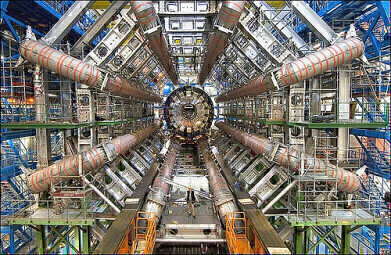News & Views
What's Wrong with Particle Physics?
Mar 17 2016
Scientists are continually pushing the limits of what’s known, trusted and accepted. Even the most solid of theories can be shaken up and reduced to nothing more than a flawed concept. The latest research from CERN has done just this, suggesting that ‘new physics’ could be closer than we think.
The data addresses the theory of particle physics, with a specific focus on B meson. Currently, the Standard Model is extremely specific about the frequency and angle of B meson decay. But now, CERN scientists are asserting that this doesn’t align with the results gathered from a recent experiment.
“To put it in terms of the cinema, where we once only had a few leaked scenes from a much-anticipated blockbuster, the LHC [Large Hadron Collider] has finally treated fans to the first real trailer,” explains Professor Mariusz Witek, co-author of the paper.
B meson stirs the particle pot
According to the Standard Model, all known subatomic particles are encompassed into a single theory. All up, the model consists of six quarks, six leptons, four force carrier particles and the Higgs boson. The B meson is formed from a down quark and a bottom antiquark, with a decay rate of 0.0015 nanoseconds. Once decayed into different sets of particles, the Standard Model maintains that each particle will be powered by a certain level of energy, and emitted at a specific angle. Until now, this was a widely accepted theory. CERN research is now challenging the assumption, having found evidence for a new form of decay that hasn’t previously been seen, let alone predicted.
“Up to now all measurements match the predictions of the Standard Model. However, we know that the Standard Model cannot explain all the features of the Universe,” said Witek. “How did the dominance of matter over antimatter in the universe come about? What is dark matter? Those questions remain unanswered. What's more, the force we all experience every day, gravity, isn’t even included in the model.”
More insight on the horizon
While the Journal of High Energy Physics paper is insightful, the research is not yet classified as an official discovery. That hasn’t quashed excitement though, with CERN already pushing forward with a new round of high energy collisions that will continue to ask questions beyond the orthodox Standard Model.
Want to know more about the latest scientific advancements shaking up laboratories, worldwide? ‘Seeing is Believing: High-Resolution Cryo Electron Microscopy reveals Mechanism of Virus Assembly and Genome Encapsidation’ explores new work led by researchers at the University of Leeds’ Astbury Centre for Structural Molecular Biology, and the ground-breaking advances they’re making in cryo-electron microscopy (cryo-EM).
Image via Flickr Creative Commons. Photo credits: Image Editor
Digital Edition
LMUK 49.7 Nov 2024
November 2024
News - Research & Events News - News & Views Articles - They’re burning the labs... Spotlight Features - Incubators, Freezers & Cooling Equipment - Pumps, Valves & Liquid Hand...
View all digital editions
Events
Nov 18 2024 Shanghai, China
Nov 20 2024 Karachi, Pakistan
Nov 27 2024 Istanbul, Turkey
Jan 22 2025 Tokyo, Japan
Jan 22 2025 Birmingham, UK




.jpg)














